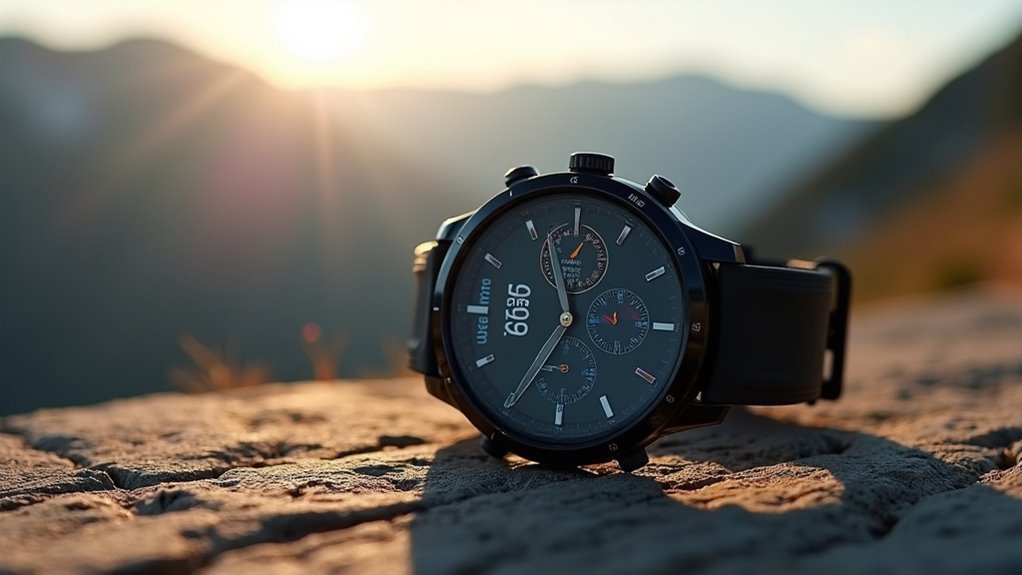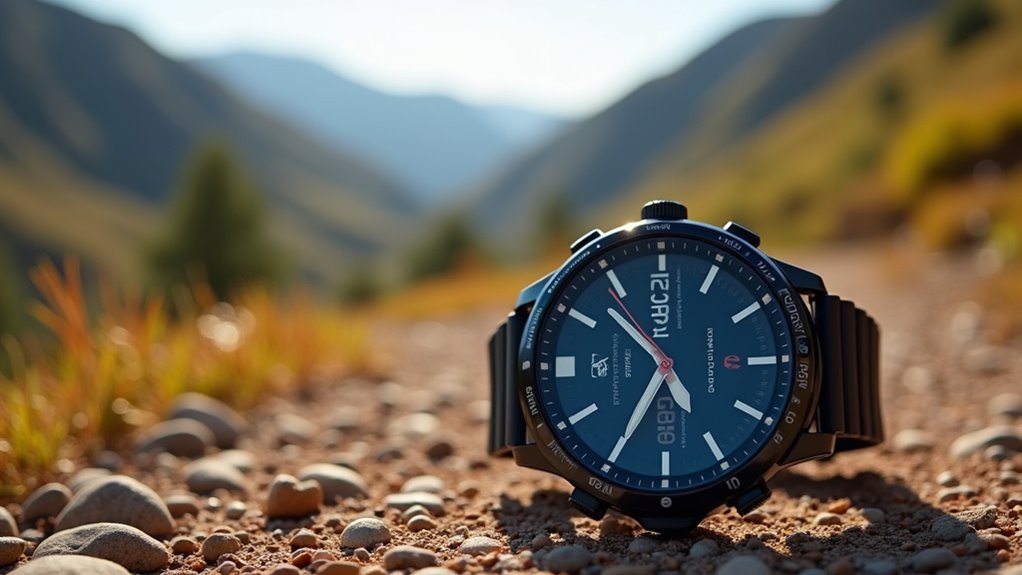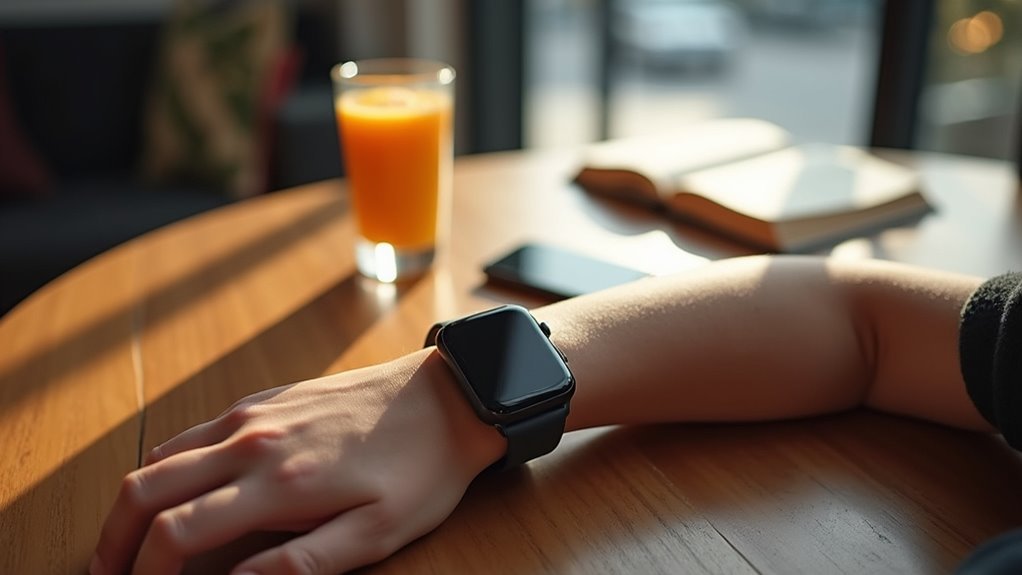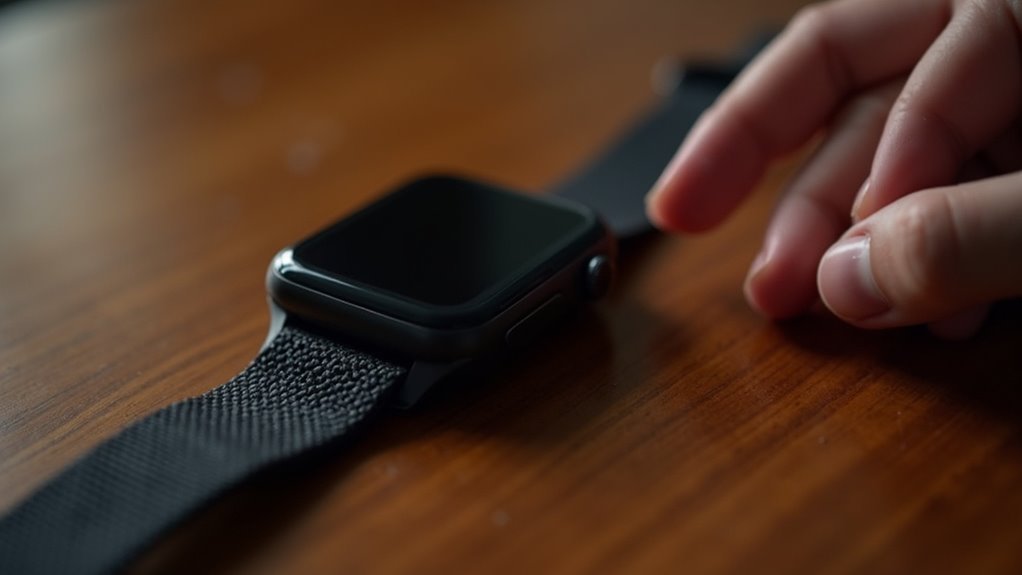For the most accurate elevation tracking, you’ll want triathlon watches that combine barometric altimeters with multi-GNSS technology. The Coros Apex 2 Pro, Garmin Fenix 7, and Polar Grit X2 Pro stand out as top performers, using sensor fusion algorithms to blend GPS and barometric data for precise real-time altitude measurements. These watches correct for GPS drift while detecting subtle elevation changes that GPS alone might miss. Understanding how these technologies work together will help you choose the perfect watch for your specific training needs.
Essential Features for Accurate Elevation Tracking in Triathlon Watches
When you’re tackling a triathlon’s varied terrain, your watch’s elevation tracking accuracy can make the difference between precise pacing and miscalculated effort distribution.
You’ll need a barometric altimeter that measures atmospheric pressure changes for real-time altitude data that’s more accurate than GPS-only estimates. Multi-GNSS support across GPS, GLONASS, Galileo, and Beidou systems enhances positioning accuracy, especially in challenging environments like urban canyons or dense forests where elevation changes are significant.
Look for watches with sensor fusion algorithms that combine barometric and GNSS data to correct altitude drifts during long activities.
Sensor fusion technology intelligently merges barometric and satellite data to eliminate altitude measurement drift during extended endurance activities.
You’ll want automatic calibration using known elevation points and dual-frequency GNSS technology to reduce multipath errors. These features guarantee seamless elevation tracking whether you’re cycling, running, or shifting between triathlon segments. Top-tier models like the Garmin Fenix 8 deliver exceptional elevation accuracy with their multi-band GPS systems, though this advanced capability comes at a premium price point.
Top Triathlon Watches With Advanced Altimeter Technology
Five standout triathlon watches deliver exceptional altimeter technology that’ll transform how you track elevation changes during training and competition.
The Coros Apex 2 Pro combines a built-in altimeter with barometer sensors, giving you real-time elevation and weather data.
Garmin’s Fenix 7 stands out with its rugged design and advanced sensors that accurately track elevation changes in harsh conditions.
The Polar Grit X2 Pro offers sophisticated GPS and altimeter features specifically designed for multisport athletes.
Suunto’s Race model integrates altimeter technology seamlessly with its thorough multisport capabilities.
Finally, the Garmin Forerunner 965 delivers precise elevation tracking through its integrated altimeter and GPS system.
Each watch provides the accuracy and reliability you need to monitor elevation changes effectively during your triathlon training sessions. Professional triathletes predominantly choose Garmin and Polar watches for competition due to their comprehensive features tailored for each leg of the race.
How GPS and Barometric Sensors Work Together for Precise Elevation Data

While GPS alone can track your elevation during training, combining it with barometric sensors creates a markedly more accurate and reliable system for monitoring altitude changes.
GPS provides your global position but suffers from atmospheric interference and satellite geometry issues that cause noisy elevation readings. Barometric altimeters measure atmospheric pressure changes, delivering stable short-term elevation data since pressure decreases consistently with altitude.
GPS elevation tracking suffers from atmospheric interference while barometric sensors provide stable short-term altitude data through consistent pressure measurements.
When fused together, GPS corrects the barometric sensor’s long-term drift caused by weather changes, while the barometer smooths out GPS elevation noise.
This partnership lets you detect subtle climbs GPS might miss while maintaining accuracy over extended periods. Modern triathlon watches use sophisticated algorithms to blend both data sources, giving you reliable elevation gain metrics essential for training analysis and race strategy. Many watches incorporate heart rate monitoring to provide comprehensive performance data alongside elevation tracking.
Comparing Elevation Tracking Accuracy Across Leading Watch Brands
When you’re choosing a triathlon watch, you’ll find that elevation tracking accuracy varies considerably between GPS-only systems and those combining GPS with barometric sensors.
Each major brand employs different sensor technologies – Coros relies heavily on built-in altimeters, Garmin uses dual GPS systems with some user input, while Polar focuses more on physiological data than elevation precision.
You’ll want to examine real-world testing results since environmental conditions can dramatically affect how accurately each brand’s approach performs during your actual races and training sessions. Recent studies reveal that accuracy can differ significantly based on environmental factors, making it essential to understand your watch’s limitations in various conditions.
GPS Vs Barometer Precision
Understanding how your triathlon watch measures elevation changes requires examining the fundamental differences between GPS and barometric tracking systems.
GPS determines elevation through satellite triangulation but struggles with vertical precision, especially in mountainous terrain or dense tree cover. Studies show GPS accuracy varies from 1% error on flat routes to 1.7% or higher on challenging terrain with significant elevation changes.
Barometric sensors measure air pressure changes and offer superior precision in stable weather conditions.
Here’s how these systems compare:
- GPS provides less accurate elevation than horizontal positioning due to weaker vertical signal resolution.
- Barometric altimeters deliver smoother elevation profiles and instant altitude change detection.
- Weather fronts can cause barometric drift, requiring GPS calibration.
- Combined GPS-barometric systems compensate for each technology’s weaknesses.
You’ll get the most reliable elevation data from watches integrating both technologies. Testing devices on familiar routes helps gauge elevation accuracy consistently across different terrain types and weather conditions.
Brand-Specific Sensor Technologies
Each triathlon watch brand approaches elevation tracking through distinct sensor technologies and algorithms that directly impact your training data accuracy.
Garmin leads with sophisticated sensor fusion, combining GPS, barometric altimeter, and three-axis compass data. The Forerunner 955 exemplifies this integration with real-time elevation alerts and cumulative metrics.
Suunto emphasizes vibration alerts tied to elevation changes, using barometric sensors to correct GPS errors effectively. The AMOLED touchscreen on models like the RACE S enhances readability of elevation data during challenging outdoor conditions.
Polar integrates elevation data with physiological metrics through proprietary algorithms that adjust for weather-induced pressure fluctuations.
Coros prioritizes sensor accuracy with advanced fusion technology that reduces GPS drift while maintaining exceptional battery life.
Apple Watch and Samsung offer basic elevation tracking through GPS-barometric combinations, though they’re less specialized than dedicated triathlon brands for serious multisport training.
Real-World Testing Results
Although manufacturers tout impressive technical specifications, real-world elevation tracking performance often tells a different story when triathlon watches face challenging terrain and environmental conditions.
When you’re testing elevation accuracy in the field, you’ll find notable variations between brands and models. Coros watches consistently demonstrate superior elevation tracking compared to competitors, while Garmin models with barometric altimeters also perform exceptionally well.
Here’s what real-world testing reveals about elevation accuracy:
- Median error rates typically range from 1-2% on varied terrain.
- Environmental factors like tree cover and urban canyons notably impact GPS signal quality.
- Mountainous terrain presents the greatest challenges for accurate elevation tracking.
- Device consistency varies dramatically between brands when measuring identical routes.
You’ll notice that watches perform best under open skies with minimal signal interference. However, barometric altimeters require periodic calibration to maintain their superior accuracy over time.
Real-Time Elevation Monitoring for Performance Optimization During Events
When you’re pushing through challenging terrain during a triathlon, real-time elevation monitoring becomes your strategic advantage for optimizing performance across every discipline.
You’ll adjust your pacing precisely as gradients change, preventing overexertion on steep climbs while maximizing efficiency on descents. Your watch displays elevation charts alongside heart rate and pace metrics, giving you instant feedback to manage energy expenditure strategically.
You can preload race courses with elevation profiles, allowing detailed planning and simulation before event day. The data helps you identify critical sections where energy changes occur, supporting smarter race tactics.
Post-event, you’ll review elevation data combined with other metrics for thorough training analysis. Professional Garmin Connect integration enables seamless data sharing between your watch and phone for comprehensive elevation tracking throughout your race. This real-time feedback transforms how you approach hills, turning elevation changes from obstacles into opportunities for competitive advantage.
Key Technologies That Enable Superior Elevation Tracking Capabilities
Behind every accurate elevation reading on your triathlon watch lies a sophisticated combination of cutting-edge technologies working in harmony to deliver precise data when you need it most.
The most advanced elevation tracking systems integrate multiple technologies:
- Barometric Altimeter Technology – Uses atmospheric pressure changes to calculate elevation more accurately than GPS alone, especially during steep climbs or in areas with poor satellite reception.
- Multi-Band GPS Reception – Utilizes multiple satellite frequency bands to enhance signal quality in challenging environments like dense forests or urban canyons.
- Sensor Fusion Algorithms – Combines data from GPS, barometric sensors, accelerometers, and gyroscopes to filter noise and provide real-time vertical speed calculations.
- Regular Firmware Updates – Continuously refines calibration parameters and algorithms to adapt to seasonal variations and improve overall accuracy.
Many devices include altimeters for elevation data to provide comprehensive training metrics that enhance athletic performance across all three triathlon disciplines.
Choosing the Right Elevation Tracking Watch for Your Triathlon Needs
When you’re selecting a triathlon watch for elevation tracking, you’ll need to balance essential features like barometric altimeters and GPS accuracy against your specific performance requirements and budget constraints.
Your choice should align with whether you’re tackling standard Olympic distances or ultra-endurance events that demand extended battery life and premium tracking capabilities.
Consider how much you’re willing to invest in advanced features versus settling for mid-range models that still deliver reliable elevation data for most triathlon scenarios. The price spectrum ranges from under $200 for basic models to over $1000 for watches with comprehensive elevation monitoring and advanced analytics.
Essential Features to Consider
Since elevation tracking can make or break your triathlon performance, you’ll need to focus on specific features that deliver accurate, reliable data across all three disciplines.
Your watch’s barometric altimeter is non-negotiable—it provides far more precise readings than GPS alone. Look for dual-frequency GNSS support to enhance accuracy in challenging terrain and urban environments.
Consider these essential capabilities:
- Auto-switching between swim, bike, and run modes to maintain consistent elevation tracking throughout your race.
- Real-time elevation feedback for immediate pacing adjustments during climbs and descents.
- Waterproof design with shock resistance to protect sensors during intense efforts and water exposure.
- Live elevation charts and customizable data fields for strategic race planning.
Remember that frequent calibration and long battery life guarantee your elevation data remains reliable during extended events. The watch should also provide advanced metrics including heart rate, pace, cadence, distance, and elevation to give you comprehensive performance insights during training and competition.
Top Watch Recommendations
Four standout watches dominate the triathlon elevation tracking market, each offering distinct advantages for different athlete needs and budgets.
The Garmin Forerunner 955 and 965 lead with advanced GPS and barometric altimeters, delivering up to 31 hours of battery life.
For extreme durability, the Garmin Fenix 7 provides 57 hours GPS runtime and 10 ATM water resistance, perfect for rugged courses.
Suunto’s Race excels in multisport shifts with reliable barometric sensors and thorough mapping features.
You’ll appreciate its smooth elevation tracking across swim-bike-run phases.
Polar’s Vantage V3 offers exceptional 61-hour battery life with dual GPS-altimeter accuracy, while the budget-friendly Pacer Pro delivers dual-band GPS precision. The Vantage V3 supports over 150 sports profiles with triathlon-specific elevation metrics for comprehensive training analysis.
COROS Apex 2 Pro dominates endurance events with 75-hour GPS capability and robust 50-meter water resistance for extreme conditions.
Budget Vs Performance
Finding the perfect elevation tracking watch means balancing your athletic ambitions with financial reality.
Budget-friendly options starting around $200-$300 offer acceptable elevation tracking through GPS, while high-performance models costing $500+ deliver superior accuracy with built-in altimeters and multi-band GPS.
Here’s what you’ll sacrifice with budget models:
- Advanced elevation sensors – You’ll rely on GPS rather than precise altimeters
- Multi-band GPS connectivity – Standard GPS can struggle in challenging terrain
- Comprehensive training metrics – Fewer data points for performance analysis
- Extended battery life – Less endurance for ultra-distance events
Consider mid-range options like the Coros Apex Pro for balanced performance.
You can also save money by purchasing last year’s models without compromising essential elevation tracking features.
Frequently Asked Questions
How Often Should I Calibrate My Triathlon Watch’s Elevation Sensors?
You should calibrate your triathlon watch’s elevation sensors frequently, especially when changing elevations or environments. Manual calibration before each training session guarantees ideal accuracy, as pressure changes can affect barometric altimeter readings.
Can Weather Changes Affect My Watch’s Elevation Tracking Accuracy During Races?
Weather changes can slightly affect your watch’s elevation tracking accuracy. Heavy cloud cover and storms may weaken GPS signals, but most triathlon watches have weather-resistant designs that minimize these impacts during races.
Do Elevation Tracking Watches Work Accurately in Underwater Swimming Portions?
Your elevation tracking watch won’t work accurately during underwater swimming. GPS signals can’t penetrate water effectively, and barometric sensors need air exposure to function properly, making underwater elevation measurement unreliable.
What’s the Typical Battery Drain When Using Continuous Elevation Monitoring?
You’ll experience battery drain rates between 5-15% per hour during continuous elevation monitoring. Your watch’s specific model and active features determine the exact drain, with high-end models offering better efficiency.
Can I Use My Triathlon Watch for Mountaineering Elevation Tracking?
You can use your triathlon watch for basic mountaineering elevation tracking, but it won’t replace specialized mountaineering devices. You’ll need manual calibration and shouldn’t rely on it for critical navigation decisions.
In Summary
You’ll find the best elevation tracking comes from watches that combine GPS with barometric altimeters, like Garmin’s Fenix series or Polar’s Vantage models. Don’t overlook Suunto’s offerings either – they’re particularly strong for altitude accuracy. Your choice should depend on your specific needs: real-time climbing data, post-race analysis, or training optimization. Remember, you’re investing in precision that’ll directly impact your performance monitoring and race strategy across all three disciplines.





Leave a Reply